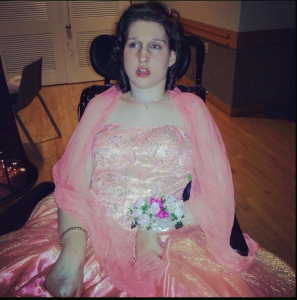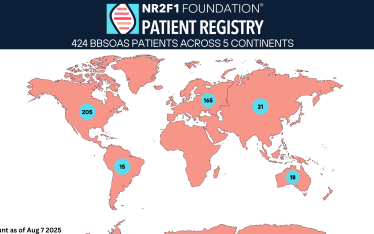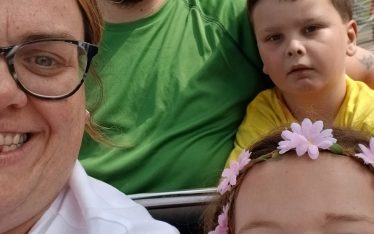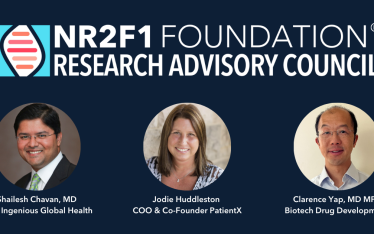A Sibling’s Perspective on Rare Disease
Brian Read joined the NR2F1 Foundation in early 2024, after applying to an advert on LinkedIn for a new Treasurer. While Brian isn’t a BBSOAS parent, he is in fact a rare disease sibling. Coupled with his skills and qualifications as an accountant, this really stood Brian out. As soon as we spoke with him we knew Brian would be an incredible asset to our team, and we weren’t wrong.
April 10 is National Sibling Day. So we are turning April into ‘Sibling Month’. To mark this, Brian has graciously agreed to share his very personal story of being a brother to his wonderful sister, Stephanie, who had Ohtahara Syndrome. Make sure to read all the way to the end. Brian and his family have made a very generous offer to the NR2F1 Foundation.
Q: Can you tell us about your sister, Stephanie’s diagnosis? How did you first learn about it, and what was your initial reaction?
Stephanie was just two weeks old when she began having seizures. I was three at the time, so I don’t remember the exact moment—but I remember the shift.
Stephanie was posthumously diagnosed with Ohtahara Syndrome, a rare neurological disorder that includes a severe form of epilepsy and significantly impacts motor skills. At that age, I didn’t understand the clinical side of it—but I knew Stephanie needed more care than any other kid I knew. She was my only sibling at the time, so her needs didn’t seem “different” to me—they just were.
Later, my younger sister Rachel was born, and the three of us grew up together. But Stephanie was always the center. She was the gravitational force around which our family moved.
Q: How did Stephanie’s condition affect your family dynamics and your role as a brother?
For me, it felt normal. My parents worked hard to make sure I had a typical childhood, even as they managed Stephanie’s care. But now, as a parent myself, I realize just how much effort that took. The level of time, attention, and love they had to pour into making things work – between medical appointments, therapies, and everyday life – was extraordinary.
At the same time, my parents never hid Stephanie away. My dad was a high school band director, and every year, he would walk Stephanie down local parade routes in front of thousands of people. He set the tone early: she was part of our family, and our family was part of the community. That example shaped how I thought about her – there was never any question that she belonged.
My mom would stay home full time to care for us, and manage Stephanie on a daily basis. She had the daily interactions with all of Steph’s caregivers, bus drivers, teachers, etc, that helped provide Steph the amazing life she had.
Q: What kind of emotional toll did Stephanie’s illness take on you personally? Did you ever feel overwhelmed or unsure of how to support her?
Absolutely! No one really knew how to support her—this was the ‘90s, before rare disease communities were connected online, before families had access to networks and resources, before technology allowed for fast and easy research into ‘one-off’ questions on rare genetic disorders.
But at the same time, I never hesitated to talk about her. Stephanie was my sister, and I wanted people to know about her. I’d tell anyone who would listen about her journey and situation. When it was just the two of us, me and Steph, I would lay next to her and talk about whatever was on my mind. Even though she couldn’t respond in the way most siblings would, I knew she was listening.
Q: Were there any specific moments during Stephanie’s illness that left a lasting impact on you?
The hardest moments were the medical related events. Long hospital stays, learning about feeding tubes, observing and treating seizures, and dealing with significant surgeries at a young age. I didn’t always understand what was happening, but I could feel the weight of it.
The Western Pennsylvania School for the Blind played a huge role in Stephanie’s life. Their educators and administrators gave her not just support, but joy. Seeing her experience things like prom, parades, and friendships through that school opened my eyes. These weren’t just services—they were lifelines. They showed me how powerful specialized education and community care could be. Families navigating rare diseases need infrastructure for genetic testing, funding for ongoing research, and comprehensive support to help their children thrive.
One moment that really hit me was when my first daughter was born. All of those childhood memories came flooding back – watching my parents care for Stephanie, the medical complexities, the love. It puts everything into perspective.
Q: Can you describe the challenges your family faced in terms of understanding the disease, accessing treatments, or seeking support?
The biggest challenge was not having a formal diagnosis while she was alive. We didn’t learn that Stephanie had Ohtahara Syndrome until after she passed. Similar to NR2F1, there were no specific genetic tests that included the specific panel Stephanie needed.
Imagine going years without knowing what’s wrong with your child. That’s the reality for so many rare disease families. My parents had to make every medical decision without the full picture, without an official name for what they were up against, without proven research and testing, and with a limited community of those in similar situations.
Q: Looking back, how did your experiences with rare disease shape your outlook on life?
Live now. There’s no time to wait for the “perfect” moment or the right circumstances. You have to appreciate the people in your life while you have them, appreciate the ups and downs as they come, and take chances.
I recently heard a saying – “choose your hard.” Meaning, life is always full of challenges – waking up early is hard, but sleeping in and being late and frazzled is hard too. It’s your choice. And there are people like Stephanie who don’t have the kind of choices most of us take for granted.
Q: How did you balance being a sibling to Stephanie while managing your own life, school, or career?
I was only 23 when she passed, so most of my time as her brother was spent growing up alongside her.
Even as a kid, I made sure to prioritize her experiences. One of my favorite memories was her school prom. It was something we made a big deal out of because she deserved those moments just like anyone else. She lit up the room!
Q: At what point did you decide to get involved with a rare disease charity? What motivated you to take that step?
After Stephanie passed away in 2013, I spent years trying to find the “perfect” way to honor her and make an impact. But in trying to make it perfect, I never actually started. It took me until 2023 to finally take action. I realized that waiting for the perfect plan wasn’t the answer—just doing something was what mattered.
Finding the NR2F1 Foundation was a true ‘ah ha’ moment for me. As I mentioned, my parents and family didn’t have a formal diagnosis. The work this Foundation is doing across research, advocacy, and community outreach is fantastic, but learning about the broader rare disease network has been eye opening.
Q: What drives you to help raise awareness and fund research for BBSOAS, especially considering your personal experience with Stephanie?
It’s personal. I know what it’s like to grow up with a sibling in the rare disease community. I know what it’s like to see doctors struggle for answers, to watch my parents navigate an uncertain path, and to experience the highs and lows of it all.
I had the chance to attend the NR2F1 Foundation conference last year (2024), and it was an emotional experience. Seeing these kids and families reminded me of my own childhood. It solidified why this is the right group of people to help move the needle on this disease.
Q: How does your personal story influence your work on the board of the NR2F1 Foundation?
I bring the sibling perspective. Parents are often the primary voices in rare disease advocacy, but siblings have a unique experience that’s often overlooked. We grow up as secondary caregivers, as emotional anchors, as the ones who carry these memories forward.
It’s something I take seriously, and it’s part of why I wanted to step up and be part of something bigger.
Q: What do you think the general public should know about rare diseases and the challenges families face?
People don’t realize how few answers exist for rare diseases. Think about the last time you were sick – you went to the doctor, you got a test, you received a diagnosis, and then you probably received a treatment plan.
Now imagine being stuck in steps one and two for years – sometimes decades. That’s what rare disease families face.
Organizations like the NR2F1 Foundation are working to change that. The potential here isn’t just about treatments – it’s about early detection, prevention, and support.
Q: What advice would you give to other siblings or family members of individuals with rare diseases?
- Embrace it. You have a unique role in their life.
- Become their advocate. They need you.
- Show them off. They are incredible.
- Talk about it. The more we share, the more we build awareness, connection, and change.
On that note, we have two announcements!
First, I am super excited to share that the NR2F1 Foundation will be launching a sibling support group in 2025! With my youngest sister and I participating in “SibShop” at Stephanie’s School growing up, I know firsthand how important it is to have a space where siblings can connect, and support each other – because our stories and journeys should be shared. Stay tuned for more details and timing!
Finally, I’m asking for your help. The NR2F1 Foundation has established partnerships with world-class research labs to uncover new treatments for NR2F1. Importantly, we have multi-year commitments to ensure continuity in this research. Your support for this effort could be life changing. Any amount raised during April (“Sibling Month”) up to $5,000 will be matched by my family in honor of my sister, Stephanie. This isn’t just about Stephanie – it’s about every family who’s ever felt alone in a doctor’s office and every sibling who’s ever whispered into the silence hoping their brother or sister could hear them.
A link to this campaign can be found here.
Thank you!
Brian Read, Treasurer
Brian.Read@nr2f1.org
Carlie is the Vice President of the Board of Directors for the NR2F1 Foundation, a registered 501(c)(3) non-profit organization dedicated to those living with rare mutations on the Nr2f1 gene.
With a B.S. in Special Education and a M.S. in Counseling, Carlie has worked at EPU Children’s Center as a Resource Specialist serving parents of children living with disabilities and then directed a parent leadership group for disability advocacy through storytelling and public speaking.
Carlie lives with her husband Jeff and their two daughters, one of whom has the rare Nr2f1 gene mutation, in Royal Oak, Michigan. She wants all Nr2f1 families whose lives have changed dramatically to know they are not alone.






